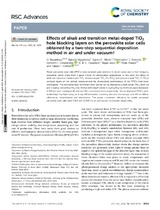| dc.contributor.author | Ngqoloda, Siphelo | |
| dc.contributor.author | Nwankwo, U. | |
| dc.contributor.author | Nkele, Agnes Chinecherem | |
| dc.date.accessioned | 2020-12-15T07:28:07Z | |
| dc.date.available | 2020-12-15T07:28:07Z | |
| dc.date.issued | 2020 | |
| dc.identifier.citation | 19. Ngqoloda, S. et al. (2020). Effects of alkali and transition metal-doped TiO2 hole blocking layers on the perovskite solar cells obtained by a two-step sequential deposition method in air and under vacuum. RSC Advances,10(22),13139-13148 | en_US |
| dc.identifier.issn | 2046-2069 | |
| dc.identifier.uri | 10.1039/d0ra01532f | |
| dc.identifier.uri | http://hdl.handle.net/10566/5511 | |
| dc.description.abstract | Planar perovskite solar cells (PPSCs) have received great attention in recent years due to their intriguing properties, which make them a good choice for photovoltaic applications. In this work, the effect of alkali and transition metal-doped TiO2 (cesium-doped TiO2 (Cs-TiO2) and yttrium-doped TiO2 (Y-TiO2)) compact layers on the optical, structural and the photovoltaic performance of the PPSCs have been investigated. The perovskite layer syntheses were carried out by depositing a lead iodide (PbI2) layer via spin-coating; converting PbI2 into methyl ammonium iodide (CH3NH3PbI3) by chemical vapor deposition (CVD) and spin-coating at 60 min and 60 s conversion times respectively. | en_US |
| dc.language.iso | en | en_US |
| dc.publisher | Royal Society of Chemistry | en_US |
| dc.subject | Alkali | en_US |
| dc.subject | TiO2 | en_US |
| dc.subject | Perovskite solar cells | en_US |
| dc.subject | Electron transport layer | en_US |
| dc.subject | Hole transport layer | en_US |
| dc.title | Effects of alkali and transition metal-doped TiO2 hole blocking layers on the perovskite solar cells obtained by a two-step sequential deposition method in air and under vacuum | en_US |
| dc.type | Article | en_US |

